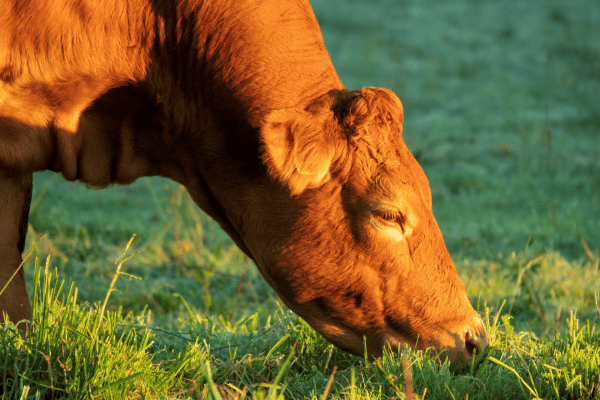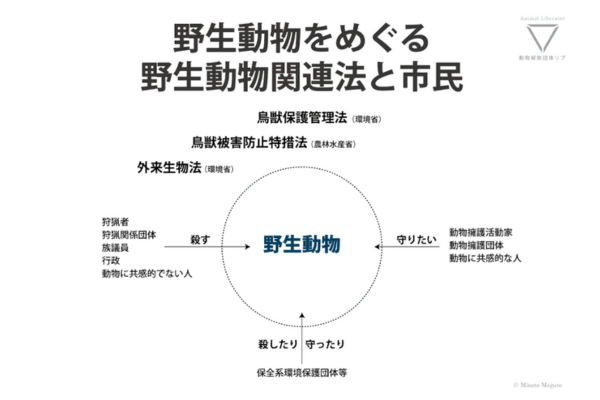This is a guide for activists who want to do dolphin activities, people who want to do something for dolphins, people who are interested in learning about dolphins and dolphin hunting.
A guide to visit, observe and investigate dolphin hunting.
Table of contents
- The purpose of this guide and how to use it
- Preparations
- Flow of the day
- Where dolphins are
- Facilities, historic sites, etc.
- Conclusion
- Information Materials
1. Purpose of the guide and how to use it
How to use:
The “Dolphin Hunting Survey Complete Guide” is designed to be open and informative at each stage of your journey, much like a global travel book.
When planning a trip or booking accommodation go to:”2. Preparation“
On the day of the survey, what time to get up, where to go, and what to do go to: “3. Flow of the day.” The spots you should see are: “4. Where dolphins are” and “5. Facilities, historic sites, etc.” If you are hungry, you can also search for a restaurant in: “2. Preparation” or 4. Meals.
Please add this page to your favorites so that you can always open it as a friend on your trip. The dolphin hunting survey, is an invaluable part of your trip, and will surely help you.
Purpose:
An increasing number of people feel that they must change their way of thinking about dolphins and protect them.
Behind the fun dolphin show, dolphins have been found to be suffering from mental illness and physical illness due to imprisonment.
It has become clear that many of the dolphins in aquarium shows around the world are caught by Japanese dolphin hunts.
We also know that some dolphins not taken captive are killed and eaten.
We Japanese are the ones who capture, use and kill the most dolphins in the world.
If we Japanese change, we can greatly reduce the suffering of dolphins.
The author of this guide, Mr. Meguro, has visited Taiji several times and stayed for a long time. We have investigated dolphin hunting, recorded and reported on the appearance of dolphins being driven in and the appearance of dolphins being pulled up.
After reading books about Taiji, visiting historic sites, and talking to many people, including Taiji townspeople, lawmakers, and people in the government office, I can say that visiting Taiji and actually seeing dolphin hunting and dolphins is an invaluable experience.
I feel that more and more people like me want to know about Japanese dolphin hunting, which is the source of the suffering of dolphins, and want to see it with their own eyes.
This guide is for such people.
I want you to go see, experience, and experience dolphin hunting with your guide in one hand. And I want it to be an opportunity to do something about it.
Each person’s thoughts and actions move people and society.
Let’s release the dolphins.
2. Preparation
In the preparation section, we will tell you about specific travel preparations and answer questions and concerns that many people have.
1. Travel preparation
1. How to make a schedule
First, answers to questions many people wonder about.
Q. Is there dolphin hunting on weekends and holidays?
A. Yes. I think many people will visit on weekends and holidays. Unless the weather is stormy, dolphin hunting will take place.
Q. How often do dolphins get caught in this hunting?
A. It varies depending on the season, the weather, and the time when dolphins migrate. Even if you go to see dolphin hunting, you don’t catch dolphins every time. Of course, it’s best not to catch dolphins, but it’s also important to actually witness dolphin hunting. The longer you stay at one time, the more likely you are to see dolphins.
Q. On what kind of days is dolphin hunting not carried out?
A. On stormy days or during typhoon. Wind is more important than rain for dolphin hunting. Even if it is raining, if there is no wind, they may go out, and even if it is sunny, if the wind is strong, they will not go out. On the day after a typhoon, check the strength of the wind and predict whether or not hunting starts.
Here, we will introduce two patterns of schedules using Saturdays and Sundays. If you can stay for a long time, it is a good idea to use it as a reference for the first stay.
Pattern 1 is recommended, since you can observe the hunting twice.
Pattern 1
Friday arrival at Nachikatsuura Night: Accommodation
Saturday morning: observe hunting until Noon: Taiji town tour Night: Accommodation Sunday morning: observe hunting, lunch: tour of Taiji town evening: return home
Pattern 2
Saturday morning: Arrive at Nachikatsuura Day: Visit Taiji Town Night: Accommodation Sunday morning: observe dolphin hunting, lunch: tour of Taiji town evening: return home

2. Transportation
Travel either by car, train, or a highway bus.
It’s best to stay in Nachikatsuura, next to Taiji, so head to Nachikatsuura. However, if you start from Nachikatsuura, you need a car.
Go by car or rent a car locally.
*Rent-a-car 660 is cheap.
Car rental service comparison.
Travel from Tokyo
Car: Tokyo → [Navi search] → Nachikatsuura (7 hours ~)
Train: Tokyo [Tokaido Shinkansen] → Nagoya Station [JR Kisei Main Line Limited Express] → Kii-Katsuura Station (5 hours 30 minutes ~)
High-speed bus: (As of 2021, operation is suspended due to Covid)
Travel From Osaka
Car: Osaka [Hanwa Expressway] [Kisei Expressway (free section)] → Susami Minami IC [R42] → Nachikatsuura (3 hours 30 minutes ~)
Train: Shin-Osaka Station [JR Kisei Main Line Limited Express] → Kii-Katsuura Station (3 hours 30 minutes ~)
3. Accommodation
You can stay at a hotel / a guest house, or a night in the car.
Hotel / guest house
Hotel / guest house list
In Nachikatsuura, there is Hotel Charmont,
It is a camp for foreign activists. There is also a staff member (the one in the linked photo) who is familiar with the situation at this time, so it is recommended for those who want to hear the story.
Guest House
Overnight in the car
Roadside Station Nachi (361-2 Hamanomiya, Nachikatsuura Town, Higashimuro District, Wakayama Prefecture)
Nassaenchi (3845 Nassayama, Taiji-cho, Higashimuro-gun, Wakayama Prefecture)
- For bathing, take a bath at the roadside station Nachi. There are many hot springs in the neighborhood, so please search for it.
4. Meals
MAP: Dolphin hunting Vegan Map
What vegans care about is food. We have made a map of shops and supermarkets that support vegans, so please make use of it.
MAP: Dolphin Hunting Vegan Map
Marker colors:
Blue: Vegan compatible
Green: Supermarket, etc.
Meals on days of dolphin hunting observation
On the day of the dolphin hunting survey, wake up while it is still dark.
The progress of dolphin hunting varies from day to day.
Therefore, I can’t figure out when to eat, and I’m exhausted and end up following the progress of dolphin fishing.
Here are some recommended patterns for how to eat.
Breakfast
Eat before departure, or after arriving in Taiji, eat what you have prepared in advance while waiting for the dolphin hunting boats to depart.
It is recommended to buy bread from the bakery “Koppe” in Nachikatsuura for breakfast and emergency food. Please note that Sunday is a holiday.
It is also recommended to have a warm drink. Hot drinks that you drink on a cold, dark morning are soothing.
Lunch
There are 3 main patterns.
1 If there is no dolphin hunting
→ Go home and eat somewhere.
2 When there will be dolphin killing
→ The time is short, from driving in to killing and landing without interruption. No time to eat. Eat a little when you move the car, or go home and eat somewhere.
3 When capturing dolphins
→ After driving in, there is time to prepare for capture and wait for the arrival of dolphin trainer aquarium officials. You may use that time to eat.
The way to distinguish between 2 and 3 is if dolphin fishermen enter ‘Kageura’ (killing cove) one after another after driving the dolphins 2. It is 3 when most of the dolphin hunters return to the Taiji fishing port.
In the case of 3, it keeps moving. It’s a good idea to bring something that you can eat in a short time, or buy fruits or Inari, rice balls at the “Fishing Cooperative Supermarket” and eat them at the right time.
(* There is a debate about dropping money at fishery cooperative supermarkets, etc. The reason is: those who oppose the purchase because it funds Taiji Town and the fishery cooperative can benefit the continuation of dolphin fishing. Conversely by purchasing something there, you can connect with towns people and they get to know who you are. Both have advantages and disadvantages, so follow your thoughts. I think it’s good)
Dinner
Please refer to “MAP: Dolphin Fishing Vegan Map”.
If you finish eating supper in the evening and go to bed as soon as possible, so you can complete the survey the next day. I finished eating at 15:00 and went to bed at 20:00.
5. What to bring on the day of the dolphin hunting survey
Food (example)
Warm drinks and water, snacks such as rice balls, bread, bananas, nutrition bars, peanut butter, etc.
Clothing:
Morning
Knit caps, things that cover the mouth, mufflers, gloves, winter innerwear, hoodies, jumpers, winter pants, winter shoes, etc.
It gets cold in the morning. In particular, the place to observe the movement of dolphin hunting boats is from the cape, which is exposed. It’s best to dress warmer than you expect to need. Keep skin out of the open air as much as possible and block the openings (nose, mouth, ears) to prevent heat from escaping. It’s best to layer your socks and wear tall, cold- weather shoes to keep your feet warm.
Noon
Hats, sunglasses, gloves, long-sleeved T-shirts, etc.
As the sun rises, the temperature rises and it can even become T-shirt weather. Sun protection is important because there is nothing to block the sun.
Rain
Umbrella, boots, waterproof hat, etc.
The idea of clothing during the survey is similar to mountain climbing. Protect your body from temperature and sunlight by preparing clothes in anticipation of various weather conditions and flexibly putting on and taking off as required at the site.
6. Equipment
For reference, I will introduce the equipment that LIB uses during the survey.
Equipment:
Camera: Nikon COOLPIX P1000, Canon kiss
Tripod: Large tripod Manfrotto (video head), small tripod
Smartphone: 3 units (for SNS relay: Insta, Facebook, Twitter), fixed mount
Mobile router: For communication (DoCoMo is good because it is in the countryside) Rechargeable battery: Large capacity
Binoculars: Vixen’s has better cost performance
Camera bag: All of the above equipment (except for a large tripod)
Especially recommended are the Nikon COOLPIX P1000 and binoculars.
P1000: With 125x optical zoom and 250x dynamic fine zoom, it is a very good camera that can capture the appearance of dolphins swimming in the distance. It can also be used when shooting inside the butcher house from a distance. It is convenient to have one.
Binoculars: Required for dolphin hunting surveys. It is used when searching for dolphin hunting boats from the top of the cape, observing the movement of fishing boats, and observing the types and appearance of dolphins. It can be used not only for dolphin hunting surveys, but also for observing animal injuries, skin conditions, eyes, etc. at zoos, aquariums, and safari parks.
A good app to have:
It is convenient to install an application that shows the following information, such as Wind direction and speed, tide, pressure distribution, rainfall range, temperature, sunrise time. When predicting the flow of dolphin hunting locally, patterns due to the weather will gradually become visible.
7. Budget
Basic: Transportation + Gasoline + Accommodation + Meals
Others: Equipment, binoculars, souvenirs, etc.
2. Questions / Worries
Q: Are Taiji people scary?
A: I’m not scared. I have the impression that there are many kind people. They will teach you a lot and will be kind to you. Most people will be kind to you if you don’t take an unpleasant attitude.
Q: Are the fisherman scary?
A: I’ve been to Taiji for a few years now, but until now we haven’t interfered much with each other. When I meet them, I say hello and keep an appropriate distance.
However, in late 2020, the relationship between dolphin fishermen and fishermen and activists was the worst I’ve ever experienced.
Aggressive, insulting, and socially inappropriate attitudes can be offensive to fishermen and others. With that in mind, I think it’s best to keep an appropriate distance and say hello normally if you have the opportunity. As a member of society, it is important to maintain politeness, act, and choose words carefully.
Q: Are there Right Wingers?
A: Usually there are not.
Those who have seen the movie “The Cove” or Sea Shepherd videos on YouTube may find the impression strong and scary presence, but most of the time there is none.
It’s more likely on a special day, such as the day before or the first day of the dolphin hunting season.
Especially as of 2021, there are few foreign activists due to the effects of infectious disease, so it seems that the activities are less active. From my personal experience, it was okay if I treated them normally and politely. They will treat you kindly, such as lending you a leisure seat when you sit down.
Q: Are there police there?
A: During the hunting season, the police are on the land and the Japan Coast Guard is on the alert. In some cases, police officers may ask you about your duties. Some activists are trying to counter it, but I think it’s better to cooperate. For the police, we activists are on the alert, but at the same time police protect us. I personally think that it would be beneficial to let them know that you am in Taiji. There is nothing wrong with being friendly.
About Activists:
There are various activists. Some are good, others have problems. You should be careful about who you interact with.
3. Flow of the day
We have made a map of the basic route for conducting dolphin hunting surveys in Taiji Town, places where dolphins are trapped, and other facilities. Please help us when you go to the site.
GoogleMAP: Taiji Dolphin Hunting Survey Map
Marker color:
Red: 3 Flow of the day (dolphin hunting observation route)
Blue: 4 Places where dolphins are kept (sea pens)
Orange: 4 Places where dolphins are kept (facilities)
Green: 5 facilities, historic sites, etc.
Simple map:
The route of the dolphin hunting observation proceeds in the order of ① → ② → ③.

1. Get up and leave
Before sunrise, when the surroundings become slightly brighter, dolphin hunting boats depart. Therefore:
Wake up: 2 hours 30 minutes before sunrise
Departure from Nachikatsuura: 1 hour and 30 minutes before sunrise
Arrive in Taiji: 1 hour before sunrise
If you go early, you will have more time.
You can arrive at one of the following three locations.
1-1 Taiji Fishing Port: Higashinohama Parking Lot (with toilet)
1-2 Above the embankment (When approaching the embankment from the eastern beach, there is a staircase on the right end. Be careful of falling)
1-3 Old Road (Turn right at the crossroads of the pedestrian crossing that has gone up the slope of Prefectural Road 240 and go down the narrow road. It is a little wider, where the bench is placed.)
From these places, you can see off the dolphin hunting boat and take a picture.
2. Seeing off dolphin hunting boats
Before sunrise, 11 to 12 dolphin hunting boats depart in a line when the surroundings become brighter.
Here, it is good to remember the characteristics of dolphin hunting boats while shooting and relaying. The characteristic of dolphin hunting boats is whether or not banger poles are installed on the left and right sides of the boat.
A banger pole is a tool that drives dolphins. It is a metal rod about the size of a clothesline, with an umbrella-like tip to diffuse the sound. When driving dolphins, the tip is inserted into the sea and the other end is hit with a mallet, to make a loud sound, while maneuvering. When sailing, the bar is on the side of the cockpit and is down toward the front of the ship. (See photo)
When the dolphin hunting boat is not fishing, you can check it at the “dolphin hunting boat mooring place” on the MAP.

When the dolphin hunting boat go offshore, move to the top of the cape. One of the following three places is good on the cape.
2-1 Toumyouzaki (Turn left at the crossroads of the pedestrian crossing that has gone up the slope of Prefectural Road 240. You can see it well from the tip, but it’s a little walk).
2-2 Observatory (Turn left at the crossroads of the pedestrian crossing that has gone up the slope of Prefectural Road 240. You can see it well).
2-3 Kajitorizaki (Because it is far away, it is difficult to move by car)
If you move fast, you can see dolphin hunting boats expanding offshore.
(* Observe traffic regulations. Especially when going to 2-1 Tomeizaki and 2-2 Observatory, the road is narrow and there are children, so go slowly. 2-3 Deer often appear on the road to Kajitorizaki).
3. Observe the movement of the dolphin hunting boats
Observe the movement of the dolphin hunting boats from the top of the cape.
There are only two deployments from here.
I Dolphin hunting boats have begun to drive dolphins.
II The dolphin hunting boats gave up catching dolphins and came back.
Continue observing the sea with binoculars to determine whether it is I or II. The judgment criteria are as follows.
I Dolphin hunting boats have begun to drive dolphins. Judgment criteria:
About 10 ships lined up in a row offshore, and if they were heading to the left (north), it would be judged that they had begun to drive dolphins. This line-up is also called a formation.

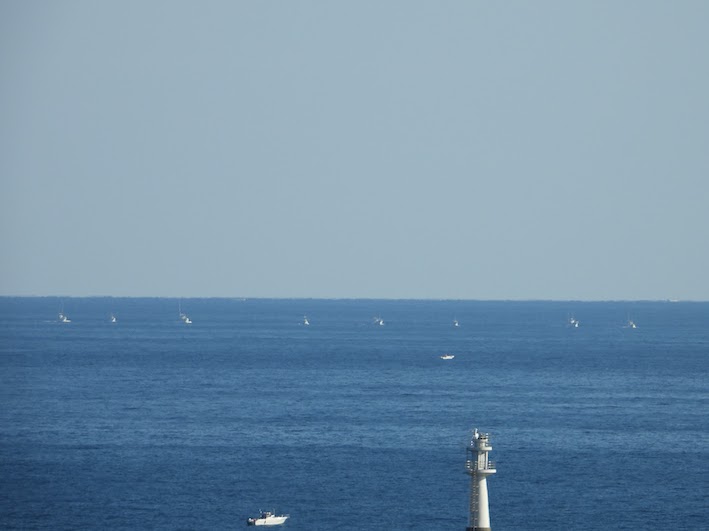
Here is the flow of dolphin fishing. If you read it in advance, you can see the flow of the day. Taiji Dolphin Hunting Documentary
II The dolphin hunting boats gave up catching dolphins and came back. Judgment criteria:
If dolphin hunting boats return in a row.
Hunting boats go beyond the horizon looking for dolphins. There are many ships off the coast, so check with binoculars and P1000.
If you look at the whole thing with binoculars, take pictures with P1000, then check if there are banger boats. There are many ships out in the sea on Saturdays and Sundays, so watch carefully. By repeating the survey of dolphin hunting, you will be able to understand the atmosphere (shape, size, color, steering method, direction and speed, etc.).
1. If it appears Dolphin hunting boats have begun to drive dolphins.
When dolphins are being driven
Go to one of the following locations:
3-1 Takababe Hill (near the tunnel in Hatajiri Bay, take the road to the hotel “White Whale”. Look left at “White Whale” and climb the road next to the embankment. Do not disturb the neighbors. Stop the car as close to the embankment as possible. (Reference: Parking space when climbing the hill). When you enter the parking lot of “White Whale” on foot, there is a staircase on the left side.
3-2 Hatajiri Bay = The Cove (Cars park in the parking lot in front of the Whale Museum. There are several places to observe. From the road above, from the small square on the side of the road, from the beach below)
3-1 Takababe Hill
Left side of Takababe:
“Kageura” the killing cove is just below the left side after climbing the stairs.
Below is the small bay where dolphins are captured and killed.
In some places, you can clearly see dolphins trying to protect their children. Also divers (dolphin hunters) entering the sea and catching dolphins, and dolphin trainers carrying dolphins. The area where dolphins are captured and killed is covered with a gray sheet so that they cannot be seen. From where you can’t see, you can hear the sounds of dolphins breathing, the sound of splashing water, the voices of dolphin hunters, and the voices of dolphin trainers sorting dolphins.
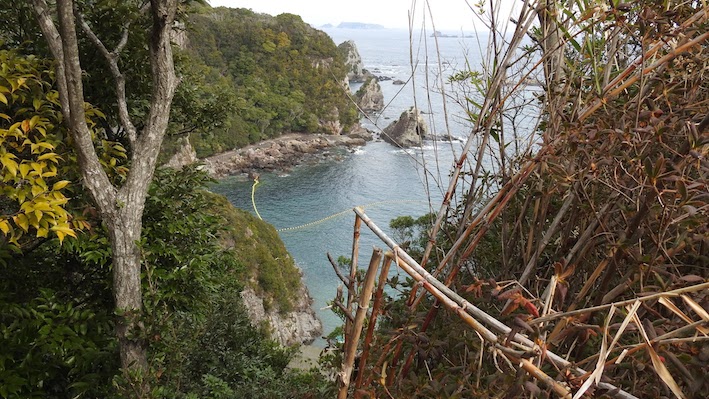

Takababe Interior:
From the innermost part of the stairs, you can see the dolphins being gradually driven from the Taiji fishing port.
When the dolphins are driven in, police officers and Taiji Town Hall officials are on the alert.
3-2 Hatajiri Bay = The Cove
You can observe dolphins trapped in fishing nets and dolphin hunting methods that gradually narrow the nets. “Kageura” (killing cove) is invisible behind the rocks.
When the dolphins are driven in, Hatajiri Bay is being watched by police officers and the Japan Coast Guard.
Depending on the day, Fisheries Agency staff, Fisheries Agency-related research institute staff, animal vocational school teachers and students, etc. visit.
Surveillance cameras are installed here and there.
Dolphins that are to be sold to the aquarium may be left overnight in Hatajiri Bay. When I go to check the situation at night, I can hear the breathing sounds of the dolphins. Security guards hired by Taiji Town are on alert all night long.
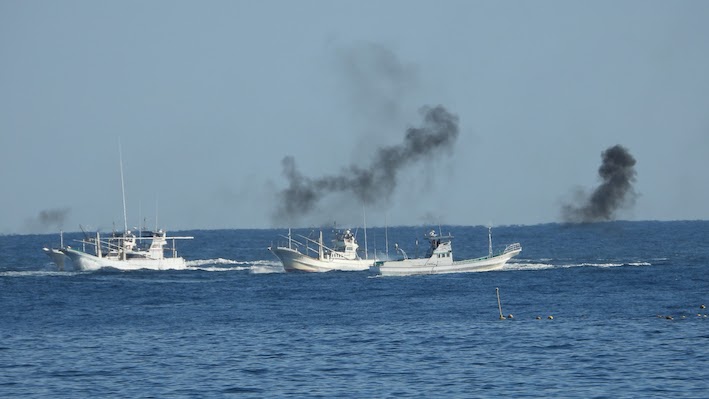
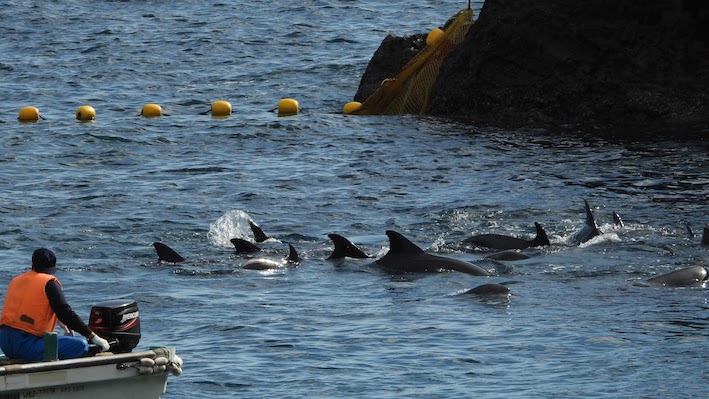
Exception- For the capture of Pacific white-sided dolphins, go to “1-2 on the embankment“
If the dolphins that have been driven are Pacific white-sided dolphin, they will be caught outside the embankment of the Taiji fishing port.
Unlike other dolphins, Pacific white-sided dolphins escape in all directions rather than in groups. Therefore, at this point, the pods of Pacific white-sided dolphins are netted and captured. Pacific white-sided dolphins are only captured for sale in the aquarium. This species is not considered delicious, so they don’t kill it.
I have also captured and killed Risso’s dolphin at this point. At this time, it took time to drive into Hatajiri Bay, so it is probable that it was captured at this point to reduce labor.
To determine if the dolphins driven in are Pacific white-sided dolphins, watch for the possibility when a small boat begins to work outside the embankment of the Taiji fishing port.
From Takababe Hill, you can check if they are doing such work, but after you move to Hatajiri Bay, you will not be able to check on this work.
In that case, if the ship arrives too late, consider whether to go “1-2 on the embankment”. Sometimes it’s just a hassle to drive in, in which case they will pass each other.
When conducting dolphin hunting observations, always try to estimate the progress of fishing and make difficult decisions ahead of time.
After the dolphins are captured and killed
The dolphin drive
I Killing
II Capture
III Release
Follow the fate of either.
I When dolphins have been killed:
Dolphin bodies are either transferred from a small boat to a dolphin fishing boat or left on the small boat, taken to the Taiji fishing port. Dolphin bodies are pulled up from the sea side of the (Facilities: #7. Wholesale Market, on Map) at Taiji Fishing Port and dismantled inside. Dolphin bodies are hidden by a blue sheet, but as they are drawn inside the butcher house, it pulls up and they may be visible through the gap.
II When dolphins have been captured
A small boat carrying live dolphins heads for the Taiji fishing port. Depending on the day, boats may also head toward Moriura Bay. The dolphins will be moved to the sea pen cages: (#1 Taiji fishing port on map) in the Taiji fishing port, and after a while, a dolphin trainer will come to measure the length and check the physical characteristics of each dolphin. Dolphins that have died from stress on the day of capture or the next day may be withdrawn from the pen and brought to the wholesale market to be sold as meat.
If dolphins are brought toward Moriura Bay, they will probably be delivered to Dolphin Base, Moriura Bay, or Nachikatsuura’s sea pen cages.
In both cases of killing I, and II capture, if you move to Taiji fishing port in a hurry (comply with traffic regulations), the killed dolphins will be pulled up to the wholesale market or captured. You can see dolphins being put in the sea pen cages. These sea pen cages can be observed well from “1-2 on the embankment”.
III When dolphins are released
There are two patterns.
① After capturing for sale in the aquarium, the net containing the other dolphins is removed, and the dolphin hunting boats will ring the banger polls to drive the remaining dolphins away. This is because otherwise, dolphins will remain around the Taiji fishing port, due to concerns about their friends. They can also get lost and go into the set nets and cause damage to fishermen’s gear.
② The remaining dolphins may be put on a small boat, carried offshore and then thrown away.
If you want to take a picture, move to “1-2 on the embankment” for both ① and ② and take a picture. For ②, you can go to “2-1 Tomeizaki” to shoot, but it will be a race against time and
it will be quite difficult. In both cases, it’s so far away that you can’t shoot without the P1000.
2. If it seems boats have given up catching dolphins and return
The place where the dolphin fishing boat departed early in the morning,
1-1 Taiji Fishing Port: Higashinohama Parking Lot
1-2 on the embankment
1-3 Old Road
Return to see the return of the ships.
Count and check the number of ships leaving the port and the number of ships returning. Depending on the day, a few boats may not come back, ase it seems that they are fishing for other things or picking up coral.
The design of each dolphin fishing boat is different, so you can observe it from “1-2 on the embankment”. In rare circumstances, fishing boats engaged in other fishing may find a pod of dolphins and contact the fishery cooperative, and then the whole dolphin hunting fleet may depart again.
3. End of hunting
When all the dolphin hunting boats and small skiff boats return to the “dolphin fishing boat mooring place” behind the Taiji Fisheries Cooperative, it is finally judged that the hunting is finished.
When most of the boats come back, hunting is virtually over, so if you have time, explore:
4. Where the dolphins are
5. Facilities / Historic sites / Others
You should visit these.
4. Advice
We will tell you how to stay safe and what you should keep in mind when you work in Taiji.
-Comply with the law (traffic code (speed limit, temporary stop, pedestrian priority), no-fly zone, drone no-fly zone, and all other laws).
・ Take measures against infectious diseases.
・ Do not be hostile to the townspeople. The dolphin hunting problem has been prolonged by people taking a hostile attitude.
・ Be careful when driving as there are many deer and wild boars.
・ About the tsunami. It is understood that the Nankai Trough earthquake will come at any
time. A promising candidate for the epicenter is the seabed just off the coast of Taiji Town. Taiji has been devastated by past tsunami. The tsunami is expected to arrive in just minutes. Protect yourself by checking the hills and routes where you can evacuate, wherever you are.
4. Where the dolphins are
After dolphin hunting is concluded, or if there is no fishing, I think it’s a good idea to go around the places where the dolphins are trapped. Dolphins are housed in floating sea pen cages or concrete and glass pools.
The sea pen cages are made of a frame and a net, with a box shape and a depth of about 3 to 4 m. When pulling up a dolphin, the net is pulled up from all sides to make it shallower so that the dolphin cannot swim before catching it.
1. Sea Pen Cages
4. Where the dolphins are located, The sea pen cages are indicated by a blue marker.
I will describe it by the route that goes around from the Taiji fishing port.
1. Taiji fishing port
Owned by Taiji Fisheries Cooperative. Stock of dolphins for sale to domestic and international aquariums and brokers
2. Whale beach cove
Hatajiri Bay = Another name for The Cove. Dolphin hunting is carried out in winter, but in summer, tourists can swim with dolphins in there.
3. Taiji Whale Museum
It is divided into a sea pen area in the whale show area and more sea pen cages in the back. Stock of dolphins for breeding, research, sale to brokers, and breeding loans with domestic aquariums. There is a rare, white variant of Rissos dolphin, “Hamata”.
When the museum opened in 1969, the short-finned pilot whale was captured and confined, but soon all died. Since then, they have confined various cetacean species, such as orca.
4. Dolphin Base
Dolphin swim, dolphin training, dolphin trainer training, etc. The president, Haruyuki Miyoshi, is a former Whale Museum employee. When the Whale Museum was founded, he was one of the people who started and established dolphin drive hunting. He made the beginning of Japanese dolphin training. A former Taiji-cho congressman, he is also now running for mayoral election. From his book, “A dream given by dolphins“.
5. Moriura Bay ①
Owned by Taiji Fisheries Cooperative. Dolphin show and dolphin training. Go through the Taiji Field Kayak office and walk along the sea sidewalk.
6. Moriura Bay ②
Unknown owner. There is also a story that there is a white variant of Hanagondou “Yuji”.
7. Moriura Bay ③
Owned by Taiji Town Whale Museum and Taiji Town Development Corporation. Moriura Bay Whale sea concept breeding dolphins, entertainment dolphins, stock of dolphins for sale to domestic and overseas aquariums and brokers.
Moriura Bay is probably the place with the largest number of confined dolphins in the world.

8. Nachikatsuura
Owner unknown (World ranch?).
2. Dolphin Pools
4 Places where dolphins are located. The facilities are indicated by orange markers.
1. Taiji Whale Museum Show Pool
A show pool from the time the Whale Museum opened. It was up-to-date when it opened in 1969. Shows of Pacific white-sided dolphins and striped dolphins.
2. Taiji Whale Museum observation tunnel pool
This pool contains an albino bottlenose dolphin, striped dolphins, spotted dolphins, rough- toothed dolphins, and melon-headed whales—all placed in a small aquarium.
3. Dolphin Resort
Features dolphin touching, dolphin training, dolphin trainer training, etc.
Reservations are required for the tour, but you can enter for free for junior high school students and above for 200 yen, 4 to elementary school students for 100 yen, and 3 years and under.
Established by Mr. Kazuichi Kaibara, who is from Osaka Prefecture. The pool where dolphin tours are currently held was once the pool of Mr. Kaibara’s villa, where he used to raise dolphins as pets. At that time, the media and others pointed out his luxurious lifestyle, such as traveling to and from Osaka by helicopter.
5. Facilities / Historic sites / Others
5. Facilities and historic sites are indicated by green markers, and others are indicated by yellow.
Listed in the order of travel route from Nachikatsuura to Taiji.
Institution:
1. Nagi
In the future, this will be connected to the sea of Moriura Bay Whale by a promenade, making it a major resort that provides hotel and recreation. Nagi’s predecessor was Green Pia Nanki, (a large-scale recreation place of pension facilities) where the existence of concessions became a problem because it was diverted to public pensions and was established in the hometown of successive Ministers of Health, Labor and Welfare. In 2007, it was said that “Nachikatsuura Town signed a lease agreement with Boao, a Chinese paper company, at the office of the Minister of Economy, Trade and Industry, Mr. Toshihiro Nikai.”
2. Road Station Taiji
The facility is owned by the town and operated by the Taiji Fisheries Cooperative. It sells dolphin meat and whale meat. The toilet is a must-see. Luxury toilet like a hotel. Taiji has the largest number of public toilets per inhabitant in Japan. The mayor of Sanken is passionate about expanding the toilets. “A town where dolphin money is turned into toilets”.
3. Whaling ship (Daiichi Kyomaru)
A catcher boat for mothership whaling. Such whaling is carried out with one huge mothership and several catcher boats. The mother ship is huge and dismantles and refrigerates whales, and the catcher boat is smaller than the mother ship and captures and kills whales. The front of the Daiichi Kyomaru is a straight road, and if you stand there, you can feel the viewpoint of a whale, being chased to be killed.
4. Taiji Whale Museum
Opened in 1969. Taiji’s modern drive hunting began to capture pilot whales for display at the Whale Museum. The method of driving dolphins with a banger is technology from the Izu Peninsula, Shizuoka Prefecture. Taiji’s earliest drive hunting was commissioned by the Whale Museum and led by fishermen. Museum staff were also fishing for pilot whales and driving with harpoons. It wasn’t until 1973 that the first successful dolphin drive hunt was successful.
5. Taiji Town Hall
This is the center of development of the industrial infrastructure using dolphins and whales, and the implementation of tourism and town policies focused on dolphins and whales. There is an office of Taiji Town Development Corporation in the government office. Taiji Town Development Corporation, along with the real estate business, is engaged in promotion projects such as (brokering) sales of living dolphins, introducing whale meat to school lunches, and promoting meat sales to rural areas. The president is the town mayor Sangen. By moving the dolphin sales from the Taiji Whale Museum to the Taiji Development Corporation, it is no longer necessary to disclose the sales destination.
6. Taiji Town Fisheries cooperative
It is composed of four fishing unions, including a fixed net union. Isana union (dolphin hunting union) is a part of Taiji fishermen’s cooperative.
7. Taiji Town Fisheries cooperative Supermarket
A supermarket directly managed by the Taiji Fisheries Cooperative. You can buy groceries such as fruits. Fresh dolphin meat and frozen whale meat are lined up. The day after the dolphin hunting, the next day, the meat of the dolphins that had just been killed is on sale. Photographing is not possible, so comply with it.
8. Wholesale Market
Owned by Taiji Fisheries Cooperative. Dolphin landing, dismantling, and dolphin meat auctions are held. It also dismantles by-catch whales. Wholesalers participate in the auction, and the day after dolphin hunting, supplying markets such as Fukuoka, Okayama, and Osaka.
9. Wada’s Rock Gate
The remains of the gate leading to the Wada family, which established old historical whaling in Taiji. Made by hollowing out a rock. Currently, houses are lined up behind the gate.
10. Stationary nets
In 2020, set nets became a hot topic because of the by-catch of minke whales and humpback whales in Taiji. Whales and dolphins are trapped as by-catch in set nets all over Japan.
11. Old-historical net- whaling boat area
In the old-historic whaling, Yamami discovers a whale and informs the whale fisherman off the coast, and the Seiko ship threatens the whale with a sound and drives it into the net spread by the net ship. At this location, the net boat was waiting for the whales to be driven in.
12. Institute of Cetacean Research (Planned construction site)
The design of the splendid building is open to the public.
13. Hiramidai
Like Tomeizaki and Kajitorizaki, Yamami was a place to spot whales and signal instructions to whale hunters during the ancient whaling era. It is also a place where unwanted human babies were thrown down.
3. Of the flow of the day
2-1 Remains of an ancient whaling facility in Tomeizaki
2-3 There is a whale memorial and a lighthouse in Kajitorizaki.
Others
- Place where you can observe dolphin sea pen cages: Moriura Bay ①
If it was not off limits, you could get off at the beach. - Place where you can see dolphin pens: Moriura Bay ①
Be careful when crossing the road. - Undercover police car waiting area
During the dolphin-hunting season, an undercover police car, is on the alert for activists, and is always on standby.
6. Conclusion
Due to the influence of the movie “The Cove”, there is an image that Taiji is a scary place. However, the actual Taiji town is a calm and laid-back place with beautiful sea and nature.
Taiji Town wants to use dolphins as a resource, and we want to protect dolphins. The positions are exactly the opposite, but humans can exchange ideas and discuss.
The people of Taiji are not homogenous. There are those who want to continue dolphin hunting, those who really want to stop, those who are not interested at all. When I asked the locals, they said that most of them weren’t interested.
I think the Japanese as a whole have a similar structure. Most have no knowledge of dolphins and are indifferent to what is happening with dolphin hunting and aquariums. If so, telling others about dolphins, what we experience and know, should increase the number of people who want to protect dolphins.
In dolphin hunting, dolphins are captured and killed one after another. In aquariums around the world, dolphins are still suffering.
We are standing on the side of dolphins and other animals and trying to release them.
I want to make that day arrive as early as possible. Liberation can be achieved by having as many people as possible interested in and expressive about animal issues.
A diversity of people may progress diverse goals by engaging in diverse activities. I hope more people will go to Taiji to protect the dolphins.
You can have the courage to go to Taiji.
I just wish you can go, to see, experience and feel.
I’m sure something will change in you. And it will be a very important experience for you.
Information Materials
GoogleMAP: Dolphin huntiing survey route
GoogleMAP: Dolphin Hunting Vegan Map
Dolphin hunting documentary and further info
Dolphin hunting Survey Complete Guide.pdf (in preparation)
Call for support
Animal Liberator’s activities are continued by your warm support.
Let’s change the future of animals and our future together.
1 Click the link
2 Select the amount of support (¥ 1,000 ~)
3 Next, enter the required information
Monthly Animal Supporter (Japanese)
Inquiries
animal.liberator.net@gmail.com
Japanese version: Dolphin Hunting Survey Complete Guide

